
Good morning you all! This has been a brutal winter here in Middle Tennessee--at least on the humans and those animals and wildlife that have to live outside. Brrrrr, I don't even want to think about them except maybe just a little bit. Today I'll be talking about Mr. Fix-it and my farm and our native warm season grass (NWSG) wildlife habitat.
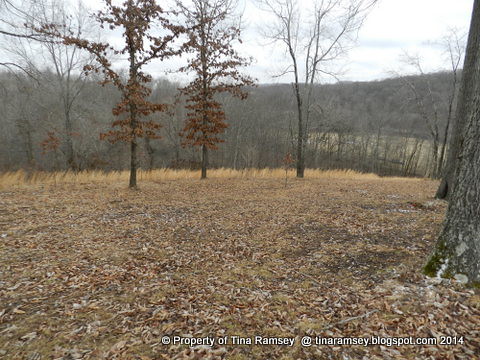
My husband and I were quite lucky to find our dream property about this time last year. Not only does the property have some nice and varied rolling terrain, but it has a lot of native plants. In fact, there are not too many invasives but the ones that are there we are working on eradicating. That land is fairly untouched and undisturbed. Today we'll discuss the native warm season grass called broomsedge, aka bluestem broomsedge, and Andropogon virginicus.
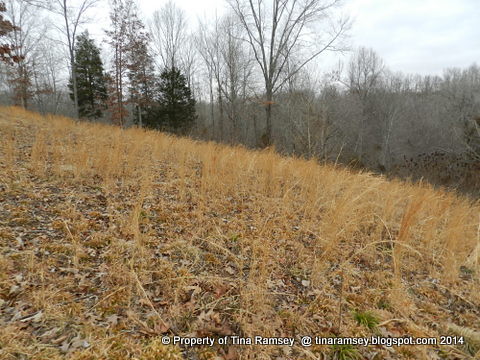
When we first purchased this land we thought this lovely bunching bluish grass was little bluestem (Schizachyrium scoparium). Then, in a meeting with two of Tennessee's wildlife biologists I received a definitive identification of all of this native warm season grass to be broomsedge--not little bluestem. Upon doing further research it is easy to see why I was confused. Both the broomsedge and little bluestem look very similar and can even grow in the same conditions. In fact, this website helps the uninitiated to determine the differences between little bluestem and broomsedge. It is not easy to tell the difference to someone not trained in these things.
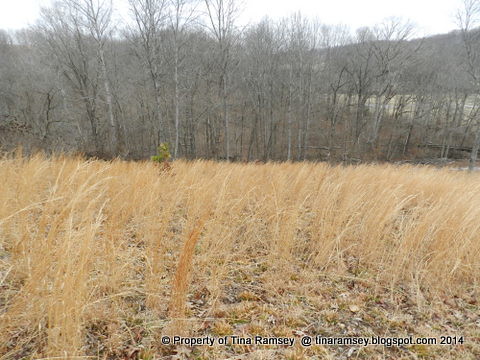
Broomsedge is a very common NWSG in Tennessee. In fact, I was informed by my neighbor's wife (a farmer's wife) that farmers hate broomsedge. Broomsedge is not particularly good forage for cattle and its presence can indicate high acidity and low fertility as well as overgrazing. On our land we already know we have high acidity but did not know about the low fertility. It all makes sense now that we see all the broomsedge. When farmers have broomsedge in their pastures they will usually add lime to get rid of the broomsedge according to my neighbor's wife. That is also the advice of many websites I have found online. Of course, you should do a soil test before you add any amendments to soil. For us we will not add lime on this hillside as that would be changing the natural state. I believe in letting nature work her course in her own way if I have a choice. And in this case I do so no lime or amendments.
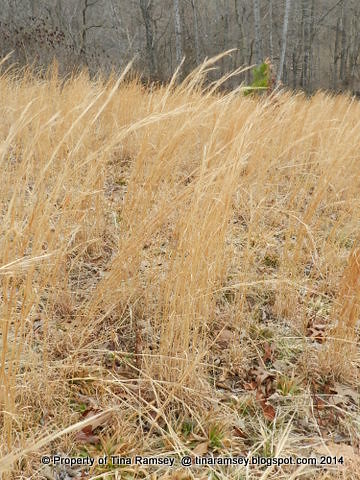
While I was a bit disappointed this NWSG was not little bluestem, the two biologists assure me it IS native and is an excellent wildlife habitat grass. The major difference between little bluestem and this broomsedge is the depth the roots travel in the ground as far as I can tell. Little bluestem roots can grow several feet down whereas the broomsedge roots pretty much stay about 12-18" deep. Deep roots would be good on this large hill but the broomsedge will help with erosion and keep the hill intact just as well as the little bluestem. This is a good thing.
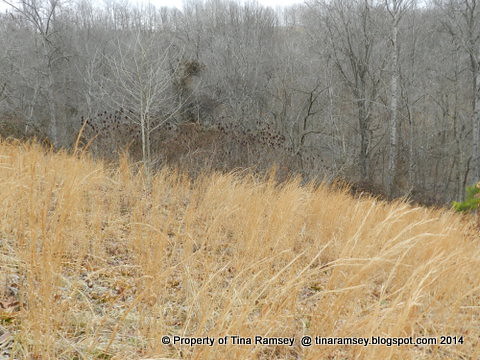
Our slope is an approximately 800' east facing slope that is surrounded by forest. At the bottom of the slope there is an old logging road; which is on our property and which we maintain; and next to that road is a stream. I had a great concern for establishing this hillside in an early succession prairie habitat so that its maintenance would be minimal and so that the stream would not be affected by runoff. As in minimal I mean only rotational mowing once a year in order to keep the woodies down. We love the natural look of this prairie area and since we have more than 50 acres of forest we wish to keep this open area open. A prairie wildlife habitat was just the solution for us and I had enlisted the aid of Tennessee's wildlife biologists to help me with that. I am taking their great advice on establishing this area to its natural state that will provide diversity for all.
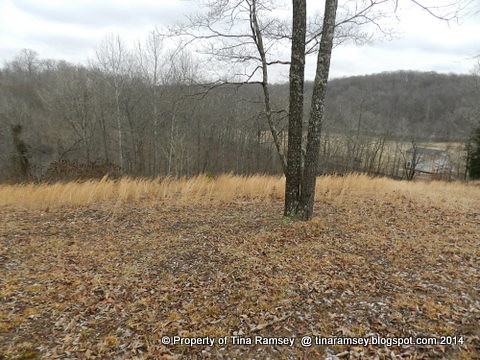
Our broomsedge helps to provide cover for deer. The deer love this hill and we can often see not only the evidence of the deer but also the deer themselves. We also have a lot of birds utilizing this area. Quail, American woodcock, turkeys, and small songbirds all like to forage and even nest in broomsedge areas. Broomsedge, because it is a clumping grass, does not completely cover the ground and is not hard for small ground dwelling birds to maneuver in and amongst the vegetation. Many of the NWSGs are like this in that they clump and do not completely mat up the ground. Many of our introduced lawn grasses will quickly cover the ground completely because they spread by runners. Introduced lawn grasses have their place but only near your home because that is where you most likely spend all of your time and where you are more than likely to do most of your maintenance. Mowing and maintaining a turf grass type grass back here would be nigh on impossible. A wildlife habitat area is the perfect solution for the wildlife and for us. Don't you just love the beautiful golden color of the broomsedge? This broomsedge has not been fazed by the weather this winter. Even after several ice storms and a couple inches of snow the broomsedge still stands proudly waving its amber waves of gold.

While this wildlife habitat of broomsedge is a good start on what I envision this hill to look like long term, it is not quite complete. Missing are native forbs such as wildflowers. There are some wildflowers growing in this area, which is a benefit but not enough to give me the diversity I desire. Diversity is not only what I desire but also I think what the wildlife desire. While I would not want to crowd the field with tons of native wildflowers I do desire things like coneflowers, compass plant, ironweed, rudbeckia, asters, and daisies to mix in with the broomsedge. There are of course some wildflowers in this area. They consist mainly of: beggar ticks, burnweed (not so great), common milkweed, passionvine, bee balm and a few others. It is possible that this year will see many more wildflowers appear now that this area has been cleared and maintained in a manner that will encourage native wildflowers to take hold and grow. To help that process a long I have ordered several pounds of a native wildflower mix formulated especially for this kind of land. I plan to aerate then frost seed the seed once it comes in. It may take a year or two for the wildflowers to grow and to really make a difference but like all gardeners, I have that vision and a lot of time to wait for it to happen. My source for my native wildflower seeds is Roundstone Seeds located in Kentucky. They come very highly rated and I am most excited to receive my seeds and see how they do. If you are into natives (who isn't now a days?) and would like to buy some seeds go check out Roundstone's website. It is a very good website and I hope to visit their farm sometimes this year.
Normally one would perhaps drillseed and also clear existing vegetation and maybe even apply amendments before spreading wildflower seeds. But, in our case we love the broomsedge and do not want to eradicate it so eliminating existing vegetation would be bad. Despite all of the broomsedge here there is plenty of bare ground for the wildflower seed to take hold. Frost seeding will help with establishing seed to ground contact as the ground expands and contracts this spring. Putting any equipment on this hillside would simply cause more damage than the good it would do because of the angle of the slope. Burning is another alternative and good way to start wildflower seeds but with the slope of this hill and with no firebreaks this is something we will forego for now. Hopefully, all will go well with seed germination and I'll let you all know later this year how it goes. So for now, I'll plan and prepare and spread my wildflower seed and enjoy the lovely broomsedge growing on my NWSG wildlife habitat....
in the garden....
It is fun to watch your farm evolve. I have seen this type of grass in many places and wondered what it was. Good luck with your seeding.
ReplyDeleteI have a hard time distinguishing one grass from another--it's good that you were able to get it positively identified. I'm envisioning this area filled with wildflowers and natives one day--a beautiful image!
ReplyDeleteI can sense your excitement as spring draws closer. What an interesting post about your broom-sedge.
ReplyDeleteHave a great week ~ FlowerLady
We have some type of grass growing in the front woods. I use to remove it but once learning that Quail like it, I left it be. And you know what? It does not bother me like it use to. I can only wonder what type of grass as I do not know my grasses. I had never heard the term Frost Seeding until now. I had to research that and it makes sense and just about what I figured it would be due to the name. Ha, what a great way to seed.
ReplyDeleteIsn't this the hill where your power lines will run? Above ground or below for the lines? I hope they do not cause much damage and can only imagine power will be run soon... So exciting!!!
Yes Skeeter, this is the hill the power lines will run up to the house. The first 350' will be above ground and the rest will be underground. We are working on the excavating cost and contractor right now to determine what is the most feasible way to go with that. We do not want the trees down and having the lines underground will be better. On the frost seeding, yes, not so many folks us it I don't think but I often do. In fact, I think we'll be doing our wildflower seed this weekend on that back 40. Grass for quali is ever so good if you like wildlife and I know you do.
DeleteI hope your seeds take off well. I really like this area of your property. Sounds like it is perfect for all the wildlife. Yet another side to your new place.
ReplyDeleteI'm so happy to hear that you are going native in your new garden. The broomsedge is lovely and the wildflowers will be too. Be sure to plant some milkweed for the Monarchs.
ReplyDeleteLove this broomsedge Tina and the plans you have for the garden.
ReplyDelete